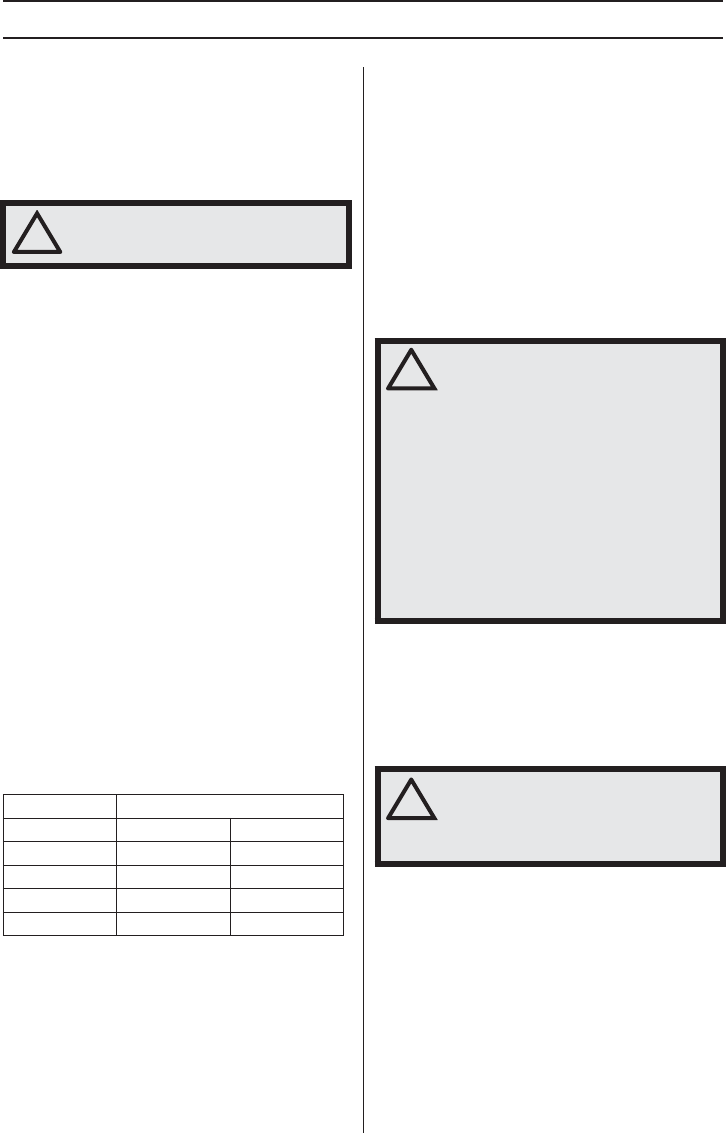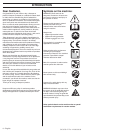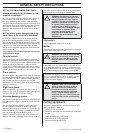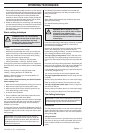
FUEL HANDLING
14 – English
5451676-47 Rev. 4 2008-08-08
Fuel
Note! The machine is equipped with a two-stroke engine
and must always be run using a mixture of petrol and two-
stroke oil. It is important to accurately measure the amount
of oil to be mixed to ensure that the correct mixture is
obtained. When mixing small amounts of fuel, even small
inaccuracies can drastically affect the ratio of the mixture.
Petrol
• Use good quality unleaded or leaded petrol.
• The lowest recommended octane grade is 90 (RON). If
you run the engine on a lower octane grade than 90 so-
called knocking can occur. This gives rise to a high
engine temperature and increased bearing load, which
can result in serious engine damage.
• When working with continuous high revs (e.g. limbing) a
higher octane is recommended.
Running-in
Avoid running at a too high speed for extended periods
during the first 10 hours.
Two-stroke oil
• For best results and performance use HUSQVARNA
two-stroke engine oil, which is specially formulated for
our air-cooled two-stroke engines.
• Never use two-stroke oil intended for water-cooled
engines, sometimes referred to as outboard oil (rated
TCW).
• Never use oil intended for four-stroke engines.
• A poor oil quality and/or too high oil/fuel ratio may
jeopardise function and decrease the life time of
catalytic converters.
Mixing ratio
1:50 (2%) with HUSQVARNA two-stroke oil.
1:33 (3%) with oils class JASO FB or ISO EGB formulated
for air-cooled, two-stroke engines.
Mixing
• Always mix the petrol and oil in a clean container
intended for fuel.
• Always start by filling half the amount of the petrol to be
used. Then add the entire amount of oil. Mix (shake) the
fuel mixture. Add the remaining amount of petrol.
• Mix (shake) the fuel mixture thoroughly before filling the
machine’s fuel tank.
• Do not mix more than one month’s supply of fuel at a
time.
• If the machine is not used for some time the fuel tank
should be emptied and cleaned.
Chain oil
• We recommend the use of special oil (chain oil) with
good adhesion characteristics.
• Never use waste oil. This results in damage to the oil
pump, the bar and the chain.
• It is important to use oil of the right grade (suitable
viscosity range) to suit the air temperature.
• In temperatures below 0°C (32°F) some oils become too
viscous. This can overload the oil pump and result in
damage to the oil pump components.
• Contact your service agent when choosing chain oil.
Fuelling
Clean the area around the fuel cap. Clean the fuel and
chain oil tanks regularly. The fuel filter must be replaced at
least once a year. Contamination in the tanks causes
malfunction. Make sure the fuel is well mixed by shaking
the container before refuelling. The capacities of the chain
oil tank and fuel tank are carefully matched. You should
therefore always fill the chain oil tank and fuel tank at the
same time.
Fuel safety
• Never refuel the machine while the engine is running.
• Make sure there is plenty of ventilation when refuelling
or mixing fuel (petrol and 2-stroke oil).
• Move the machine at least 3 m from the refuelling point
before starting it.
• Never start the machine:
1 If you have spilt fuel or chain oil on the machine. Wipe
off the spillage and allow remaining fuel to evaporate.
2 If you have spilt fuel on yourself or your clothes, change
your clothes. Wash any part of your body that has come
in contact with fuel. Use soap and water.
!
WARNING! Always ensure there is
adequate ventilation when handling fuel.
Petrol, litre Two-stroke oil, litre
2% (1:50) 3% (1:33)
5 0,10 0,15
10 0,20 0,30
15 0,30 0,45
20 0,40 0,60
!
WARNING! Taking the following
precautions, will lessen the risk of fire:
Do not smoke and do not place any hot
objects in the vicinity of fuel.
Always stop the engine and let it cool for
a few minutes before refuelling.
When refuelling, open the fuel cap
slowly so that any excess pressure is
released gently.
Tighten the fuel cap carefully after
refuelling.
Always move the machine away from the
refuelling area before starting.
!
WARNING! Fuel and fuel vapour are
highly flammable. Take care when
handling fuel and chain oil. Be aware of
the risks of fire, explosion and those
associated with inhalation.


















